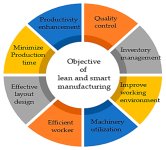Can Indian Industries Truly Achieve World Class Manufacturing Standards by 2030?
World Class Manufacturing (WCM) is more than a buzzword — it’s a complete transformation of culture, process, and productivity. It aims to bring together best-in-class practices from across the globe such as Lean, Kaizen, TPM, and Six Sigma to deliver exceptional quality and efficiency.
From Toyota in Japan to Bosch in Germany, world-class manufacturers run on the philosophy of continuous improvement — where excellence is not a destination, but a way of working.
At its core, World Class Manufacturing integrates:
These principles are all geared toward minimizing waste, improving quality, and achieving sustainable excellence across the supply chain.
While India has made massive strides in sectors like automotive, pharma, and consumer goods, it still faces challenges on the road to becoming world class:
However, success stories do exist — Bharat Forge, TVS Motors, and Tata Steel are leading by example by investing heavily in WCM programs.
Initiatives like Make in India, PLI Schemes, Skill India, and the adoption of Industry 4.0 technologies are laying the foundation. With increasing digitization, smart manufacturing, and AI-driven insights, factories in India are undergoing a quiet revolution.
Uploading an image of a modern Indian automotive production line — like Maruti or Tata — can show just how far we’ve come.
( [Image Suggestion]: Use an image showing a modern smart factory or an Indian car manufacturing plant to grab attention and improve visual engagement.)
[Image Suggestion]: Use an image showing a modern smart factory or an Indian car manufacturing plant to grab attention and improve visual engagement.)
Many organizations claim to be following World Class Manufacturing. But in reality, do their internal systems support this claim? Or is it mostly compliance on paper?
This slightly controversial question sparks debate — and that’s good. It creates discussion-driven content that boosts platform engagement.
By 2030, Indian industries can indeed become world class — but only with:
Do you think India is genuinely ready for a WCM revolution by 2030? Or are we simply chasing a Western model without adapting it to our realities?
Let's start a conversation in the comments!
World Class Manufacturing (WCM) is more than a buzzword — it’s a complete transformation of culture, process, and productivity. It aims to bring together best-in-class practices from across the globe such as Lean, Kaizen, TPM, and Six Sigma to deliver exceptional quality and efficiency.
From Toyota in Japan to Bosch in Germany, world-class manufacturers run on the philosophy of continuous improvement — where excellence is not a destination, but a way of working.
 What Is World Class Manufacturing?
What Is World Class Manufacturing?
At its core, World Class Manufacturing integrates:
- Lean manufacturing
- Total Productive Maintenance (TPM)
- Just-In-Time (JIT)
- Zero Defect systems
- Quality Circles
- Six Sigma
These principles are all geared toward minimizing waste, improving quality, and achieving sustainable excellence across the supply chain.
 Where Does
Where Does
While India has made massive strides in sectors like automotive, pharma, and consumer goods, it still faces challenges on the road to becoming world class:
- Inconsistent implementation of Lean practices
- Lack of standardization in small & medium enterprises (SMEs)
- Weak supply chain digitization
- Skill gaps in modern operations management
However, success stories do exist — Bharat Forge, TVS Motors, and Tata Steel are leading by example by investing heavily in WCM programs.
 Government Push: Can It Help?
Government Push: Can It Help?
Initiatives like Make in India, PLI Schemes, Skill India, and the adoption of Industry 4.0 technologies are laying the foundation. With increasing digitization, smart manufacturing, and AI-driven insights, factories in India are undergoing a quiet revolution.
Uploading an image of a modern Indian automotive production line — like Maruti or Tata — can show just how far we’ve come.
(
 What Needs to Change?
What Needs to Change?
- Mindset Shift: WCM is not a checklist. It’s a mindset of continuous improvement.
- Skilling Workforce: Upskilling in Lean, Six Sigma, and digital tools is essential.
- Leadership Involvement: Senior leaders must walk the talk.
- Measurement and Data: Without KPIs and real-time analytics, improvements can’t be sustained.
 A Bold Question: Are We Overhyping WCM in India?
A Bold Question: Are We Overhyping WCM in India?
Many organizations claim to be following World Class Manufacturing. But in reality, do their internal systems support this claim? Or is it mostly compliance on paper?
This slightly controversial question sparks debate — and that’s good. It creates discussion-driven content that boosts platform engagement.
 Conclusion:
Conclusion:
By 2030, Indian industries can indeed become world class — but only with:
- Real commitment to Lean thinking
- Skill-based transformation
- Integration of Industry 4.0 technologies
- Deep cultural change at every level
Do you think India is genuinely ready for a WCM revolution by 2030? Or are we simply chasing a Western model without adapting it to our realities?
Let's start a conversation in the comments!





